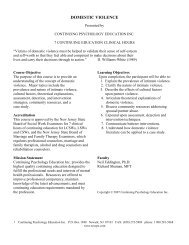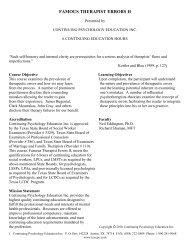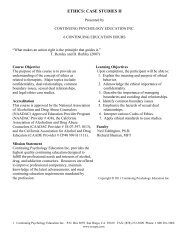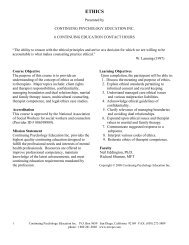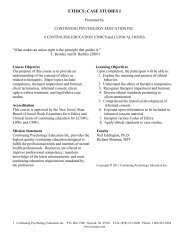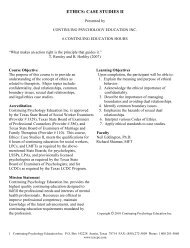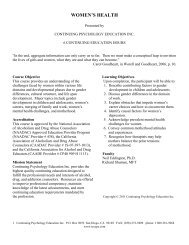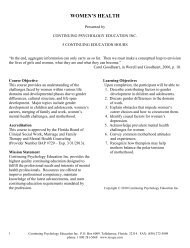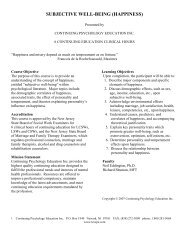<strong>FAMOUS</strong> <strong>THERAPIST</strong> <strong>ERRORS</strong>Transference is a potential cause of unrealistic perceptionin relationships and may be defined as “the client’sexperience of the therapist that is shaped by the client’s ownpsychological structures and past and involves displacementonto the therapist of feelings, attitudes, and behaviorsbelonging rightfully in earlier relationships” (Gelso & Hayes,1998, p. 51). Being aware of transference in therapy isrelevant because it is believed that the therapeuticrelationship evolves into a replication of other relationshipsin the client’s life (Teyber, 2000).The therapist’s own unresolved issues and characterdefenses can create countertransference suggesting that theremay be a pattern in each of us regarding the typical errors wemake, situations we misperceive, and the failed therapy caseswe encounter. Our own feelings of anger, fear, or love maysabotage progress with certain clients or may compel us towork overtime with other clients. Fortunately, therapistresistance, countertransference, and blockages aremanageable through self-awareness, self-monitoring,supervision, and if needed, personal counseling – often, it isundiagnosed concerns and disguised feelings that perpetuateour therapy failures. Many therapist issues are recognizablebut many are still beyond our awareness at any given time,thus highlighting the need to know how to avoid failure aswell as the need to learn from it.Mohr (1995) indicates that therapist lack of empathy,under-estimation of the severity of client’s problems, andnegative countertransference are related to negative therapyoutcome; additionally, disagreement with client regarding theprocess and content of therapy may yield poor results. Mohrprofesses, “Certainly, it cannot be too much to ask that we dowhat we ask of our patients – to examine our failings with anopen mind and with a view toward change.” Unfortunately,this researcher believes that the field of psychotherapy haschosen to avoid looking at negative outcomes and seldomreports them. He contends, “To the extent that the fieldavoids examining when psychotherapy fails, the fieldsucceeds only in limiting its own potential” (p. 24).Case studies and surveys on sexual involvement withtherapists and other therapeutic errors have been correlatedwith client deterioration. Pope and Tabachnick (1994)surveyed psychologists who were in therapy and found that22% felt the therapy was harmful due to the followingreasons: sexual acts or attempted sexual acts, therapistincompetence, therapist emotional abuse, therapist failure tounderstand them, and boundary violations.Another common therapist-client interactive variableleading to failure is counselor’s attitude of “I’ve seen it allbefore.” Experienced practitioners can become jaded intothinking that most new clients present with only a fewscenarios that are routinely repeated. For example, clientanger toward counselor may be automatically deemed“transference reaction” or shyness always means “poor selfesteemand fear of rejection.” These assumptions based onpast experience can be faulty as each individual is unique andpresents with a different history, personality, and perceptionof the world, regardless of symptoms appearing similar. Wemay then see a culmination of past events rather than what isreally there. Beginning therapists may fail with a particularclient due to lack of experience, whereas, if not cautious,veterans may do so through neglect and a waning energylevel.Excessive therapist self-disclosure can cause the client tofeel bored, ignored, and minimized and lead to clientterminating therapy. Effective usage of self-disclosure mayproduce bonding, modeling, empathic understanding,sincerity, authenticity, and can assist in moving throughclient resistance, denial, and aloofness. Concern arises whentherapist offers long and tedious self-revelations that maynegate client’s worth by implying who is really the importantone in the process, in fact, self-disclosure is one of the mostabused interventions. Therapists can also lose their value asa neutral transference figure through talking too much aboutthemselves because client may conclude “this therapist is justlike me” and they may then question the value of attendingtherapy. Revealing too much of one’s life story, trying toconvince clients of their next step and to view things the waywe do can overwhelm them into thinking that they mustconform to only one option which might stifle their personalgrowth and self-exploration.Failed therapy often occurs when clinician underestimatesthe psychopathology, which slows progress, and whenexcessive patience and tolerance is granted toward client whoviolates basics of the treatment contract such as lateness, noshows,noncompliance, late payments, and continued druguse. Additionally, Lambert and Bergin (1994) determinedthat severely disturbed clients treated with techniques thatrely upon breaking down defenses and challenging typicalpatterns of behavior or coping strategies are more likely toexperience negative outcomes. They also suggest thatintense groups with coercive group norms that promote brutalhonesty and quick fixes have been related to clientdeterioration.Contrarily, research has proposed that goal agreementbetween therapist and client can significantly assist indeveloping a positive working alliance and is associated withpositive treatment outcome, treatment engagement andtreatment compliance (Horvath & Symonds, 1991; Krupnick,1996; Martin et al., 2000; Tryon & Winograd, 2002).Definition and agreement on treatment goals is alsoassociated with client satisfaction, which, in turn, correlateswith greater treatment gains (Eisenthal et al., 1983; Holcombet al., 1998). The working alliance between therapist andclient as related to positive therapeutic outcome has receivedsignificant empirical support (Martin, Garske, & Davis,2000), whereas, disagreement on therapeutic aims betweencounselor and client can significantly hinder client progress(Tryon & Winograd, 2002). These studies collectivelyemphasize the importance of defining and negotiatingtreatment goals with clients at the beginning of therapy; thisprocess may assist therapists to articulate the relevance ofvarious treatments and to tailor treatments as needed(Uebelacker et al., 2005).14 <strong>Continuing</strong> <strong>Psychology</strong> <strong>Education</strong> Inc.
<strong>FAMOUS</strong> <strong>THERAPIST</strong> <strong>ERRORS</strong>San Martin (2007) notes that clients present with numerousgoals that are only partially associated with their diagnosis,therefore, the potential for failure exists among manytreatments not designed to resolve issues beyond those ofpresenting symptoms. She recommends that clinicians assessclient treatment goals early in therapy and then activelydiscuss with client any treatment limitations that couldimpede progress. This open discussion might “strengthen theworking alliance, increase satisfaction, and reduce earlydrop-outs.”CONFRONTING THERAPY FAILUREThough therapy failures are generally viewed with disgust,they simultaneously present creative opportunities forpersonal and professional development given an open mindset.An accepting and probing attitude toward ourtherapeutic failures can foster:• Enlightening reflection• Positive change• Beneficial information• Useful feedback on the effect of taking action• Broadened flexibility• Learning to be humble• Heightened motivation• Enhanced frustration-tolerance• Improved creativity and experimentationKottler and Blau (1989) suggest five stages that therapistsexperience upon therapy-failure awareness: illusion, selfconfrontation,the search, resolution, and application. Thepractitioner’s experience level and how a negative outcome isdefined are two variables affecting movement through thesestages. During illusion, therapists live in denial and seeksomething or someone to blame other than themselves. Theemotions of fear, anxiety, and guilt that an unexpectedlynegative outcome is occurring fuel the search. The egopursues protection through distorting reality such as claiming“I’m not at fault, it’s the client.” Next, self-confrontationinvolves self-anger/blame/doubt while therapist takes selfresponsibilityfor the error and stops blaming others. Thethird stage, the search, is driven by a desire to determine whattruly happened, leading to information-seeking and a carefulstudy of the event and its causes. Similar to the datacollection phase during scientific research, therapists exploreand analyze various possibilities though self-study andutilization of all resources. This research facilitatesunderstanding the multi-dimensionality of the experienceculminating in a broader and healthier perspective increasinglikelihood of resolution. The next stage, resolution, focuseson attaining new insights and direction allowing therapists toprocess causes of the negative event within a manageableperspective. Although therapists may never know preciselywhat went awry, they understand and accept their role in theprocess. The last stage is application of new learning infuture work. Therapist feels more determined to workcompetently and more interested in ongoing learning.Confronting failure breeds confidence, professional growth,and an appreciation of our vulnerability, which is often thecompelling force for change and growth.Kottler and Blau (1989) recommend practitioners to askthemselves the following questions in honestly assessingtheir work:− What are my expectations of the client? Of myself?− What does the client expect of me? Of him-or herself?− Are my expectations congruent with the client’sexpectations?− What is my investment in this case? What do I need fromthe client?− How aware am I of the timing necessary for the process tounfold?− What reaction is triggered in me by this client?− What am I doing that is helpful?− What am I doing that is not helpful?− How may I be getting in the client’s way?− What changes can I make?− What outside resources can I tap? Colleagues? Experts?Literature?Examining our clinical work by asking such questions canengender greater receptiveness to new information anddiscovery.Veteran practitioners accept shortcomings andimperfections of others and themselves. Through self-study,they learn of their limitations, mistakes, and misjudgmentsand they work diligently to not repeat them. Certainly, byexamining our mistakes and forgiving ourselves we cantransform therapy failures into opportunities for enhancedpersonal and professional efficacy.CONCLUSIONThese practitioners agree that therapists are human andthereby susceptible to error of many types, includingmisperceiving client response, using inappropriatetechniques, not responding to client frame of reference, andhaving neurotic lapses themselves. Such mistakes often yielddiscomfort but also, hopefully, a desire to examine the flawedsituation, take self-responsibility, gain insight and move on.Lazarus echoes these thoughts by suggesting therapistsbenefit by maintaining a balanced view of therapy withrealistic expectations allowing them to take failure in stride.Consensus abounds among these prominent therapistsregarding how refinements in technique and theory resultfrom their successes and failures. They respect their failuresand personally reflect upon these negative outcomes withimprovement as the goal. Other strategies for dealing withfailure include Lazarus’s belief in working with modestexpectations (seeking a first down rather than a touchdown),and Ellis’s objective and systematic analysis of his errors forlearning purposes. Corey’s approach is to remain open togrowth after a mistake; he understands occasional errors areinevitable and he cannot control a client’s behavior but he15 <strong>Continuing</strong> <strong>Psychology</strong> <strong>Education</strong> Inc.



